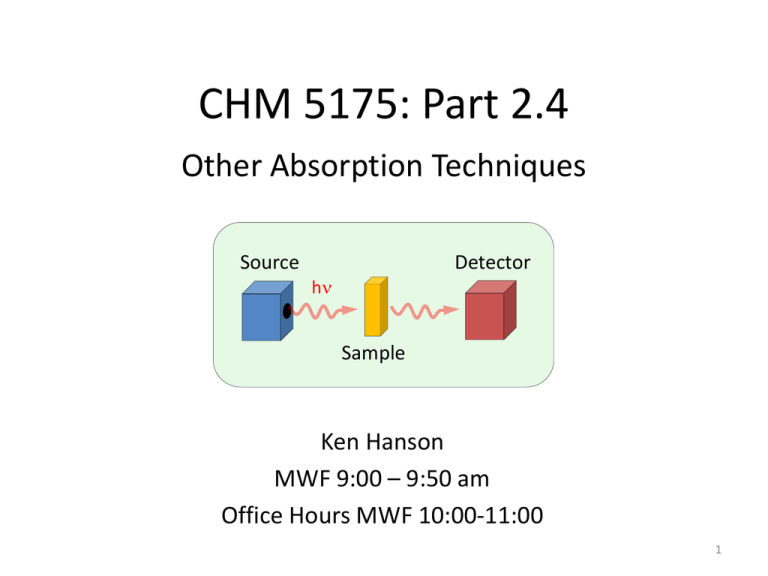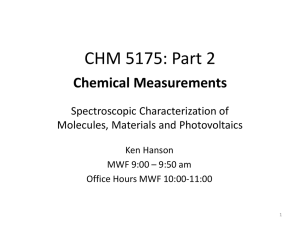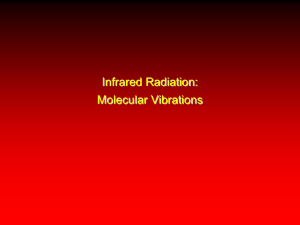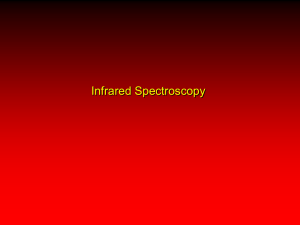Other Absorption Techniques
advertisement

CHM 5175: Part 2.4 Other Absorption Techniques Detector Source hn Sample Ken Hanson MWF 9:00 – 9:50 am Office Hours MWF 10:00-11:00 1 2013 Nobel Prize in Chemistry 1998 Nobel Prize in Chemistry 2013 Nobel Prize in Chemistry DEVELOPMENT OF MULTISCALE MODELS FOR COMPLEX CHEMICAL SYSTEMS 2013 Nobel Prize in Chemistry DEVELOPMENT OF MULTISCALE MODELS FOR COMPLEX CHEMICAL SYSTEMS 2013 Nobel Prize in Chemistry DEVELOPMENT OF MULTISCALE MODELS FOR COMPLEX CHEMICAL SYSTEMS 2013 Nobel Prize in Chemistry CHM 5175: Part 2.4 Other Absorption Techniques Detector Source hn Sample Ken Hanson MWF 9:00 – 9:50 am Office Hours MWF 10:00-11:00 8 Content Detector Source hn Sample 1) Circular Dichroism 2) Infrared Spectroscopy UV-Vis Spectroscopy Detector Sample End View Unpolarized Light Polarizers Polarization of Light Vertically Polarized Side View End View Horizontally Polarized http://www.enzim.hu/~szia/cddemo/edemo0.htm Light + Molecules Source Strong Absorption Weak Absorption Orientation Dependent Absorption Ph Ph a axis b axis Angew. Chem. Int. Ed. 2005, 44, 6564 –6568 Polarization of Light Vertically Polarized Side View End View Horizontally Polarized http://www.enzim.hu/~szia/cddemo/edemo0.htm Adding Polarized Light In phase (peak at the same time) + same amplitude Vertical + Horizontal = 45° diagonal Adding Polarized Light ¼ l (90°) out of phase + same amplitude Vertical + Horizontal = Circular Green peaks when red baselines. Sum (blue) is always 1. l/4 Wave Plate Polarizer l/4 Wave Plate Polarizer Polarization of Light left-circularly polarized Side View right-circularly polarized End View Adding Polarized Light In phase (peak at the same time) + same amplitude left circular + right circular = vertical Green peaks when red peaks. Absorption Spectroscopy P0 (power in) P (power out) P P0 Absorbance: A = -log T = log P0/P Chiral Molecules Absorption Spectroscopy The Beer-Lambert Law: A=ecl A = absorbance (unitless, A = log10 P0/P) e = molar absorptivity (L mol-1 cm-1) l = path length of the sample (cm) c = concentration (mol/L or M) e is the same for D and L If C are equal: 50:50 D to L 100% D 100% L Then A is the same. Assuming the light is unpolarized! Circular Absorption Absorbs Less Larger P left-circularly polarized right-circularly polarized Absorbs more Smaller P P0 (power in) P (power out) Circular Absorption P(left) P0(left) P0 (power in) P (power out) Absorbance: A(left) = log P0(left) /P(left) A(right) = log P0(right)/P(right) Circular Dichroism Polarizer Source Prism Process: 1) Unpolarized white light 2) Monochrometer 3) Plane polarizer 4) left-right modulator 5) left (then right) through sample 6) measure P for right (then left) through sample Circular Dichroism CD measures the difference between the absorption of left and right handed cirularly-polarized light: De is typically <10 M-1 cm-1 e is typically > 10,000 cm-1 CD spectra reported in ellipticity () or De = 3298 Δε. e in L/mol cm (liters mol-1 centimeters-1) in degrees cm2/dmol-1 (degrees centimeters2 decimol-1) Spectra Absorption Circular Dichroism CD Spectrometer AVIV 202 CD spectrometer Institute of Molecular Biophysics 170-875 nm -10oC to 110oC titrator attachment Applications • • • • • • Determination of secondary structure of proteins Investigations of protein-protein interactions Investigation of the effect of drug binding Protein structure in a membrane Stereoselective synthesis Dynamic processes - protein folding - reaction dynamics • DNA denaturation GCN4-p1 coiled–coil CD End Any Questions? Content Detector Source hn Sample 1) Circular Dichroism 2) Infrared Spectroscopy Spectroscopy e (104 M-1cm-1) 10 8 6 4 2 0 250 300 350 400 450 500 550 600 Wavelength (nm) Visible: 300-700 nm / 30,000-14,000 cm-1 Mid-IR: 2,500-15,000 nm / 4,000-650 cm-1 Mojet et al. Chem. Soc. Rev. 2010, ASAP. Infrared Spectroscopy Infrared Spectroscopy C2v: 20A1 + 19B2 + 9B1 Kincaid et al. J . Phys. Chem. 1988, 92, 5628. Applications • • • • • • Identification of inorganic compounds and organic compounds Identification of components of an unknown mixture Analysis of solids, liquids, and gasses Component quantification In measurement and analysis of Atmospheric Spectra Can also be used on satellites to probe space Infrared Spectroscopy Detector IR Source hn ? Sample Procedure Step 1: Prepare a sample Step 2: ??? Step 3: Obtain spectra (Profit!) Infrared Spectroscopy Discovered: Uranus Infrared light (1800) Friedrich Wilhelm Herschel Astronomer Infrared Sun H2O Thermometers Infrared Spectroscopy Detector IR Source hn ? Sample Infrared Spectroscopic Techniques – Direct Transmission – Reflection Absorption (RAIRS or IRRAS) – Polarization-Modulated RAIRS – Diffuse Reflectance – Photoacoustic – Attenuated Total Reflectance Direct Transmission Sources Detector Bruker 80v Sample Direct Transmission Diode Detector IR Source hn Sample Pros: Simple Standard Inexpensive Cons: In KBr No solvent No surfaces KBr Pellet Boring? Direct Transmission Diode Detector IR Source hn 0.06 % Transmittance 0.05 0.04 0.03 0.02 0.01 0.00 4000 3500 3000 2500 2000 -1 Wavenumbers (cm ) 1500 1000 500 Reflection Absorption (RAIRS) AKA: IRRAS, grazing angle IR Reflective surface Requirements – Highly Reflective Metals, glass, semiconductor – Planar – Typically monolayers Disadvantages – Weak Signal (<2% DT) – No solvent – Accessory Reflection Absorption (RAIRS) Seagull (Harrick Scientific) Sample Polarization Modulation-RAIRS Reflective surface S-polarized light phase shifts by 180° P-polarized light phase shifts by 90° (at 80° incident angle) Polarization Modulation-RAIRS p p s s Reflective surface S-polarized (180° shift) is destructive -does not contain information about the interface P-polarized (90° shift) is non-destructive -does contain information about the interface Polarization Modulation-RAIRS p P(p) P(s) s Reflective surface P(p) = solvent + surface P(s) = solvent P(p) - P(s) = surface Polarization Modulation-RAIRS 5 1 1. 2. 3. 4. Incident light is polarized PEM shifts between S and P Polarized light hits sample At the surface: -S-polarized signal is nullified -P-polarized signal is enhanced 5. Light hits the detector 6. P(p) - P(s) = surface spectrum 3,4 2 PM-RAIRS vs RAIRS RAIRS PM-RAIRS IR active IR inactive ITO Glass Slide Paniagua et al. J. Phys. Chem. C 2008, 112, 7809. Polarization Modulation-RAIRS Pros: Can use solvent Suggests orientation IR active IR inactive ITO Glass Slide Sensitive Cons: Expensive (>$200,000) Requires reflective surface Planar surface Diffuse Reflectance (DRIFTS) Factors for Scatter -Particle Size 50 mm or less -Refractive Index -Depth >1.5 mm Diffuse Reflectance (DRIFTS) Ellipsoidal Reflector Incident Sample light Detector Integrating Sphere Diffuse Reflectance (DRIFTS) Pros: Can measure scattering samples Accessory Inexpensive Cons: Need a scattering sample No solvent Not as sensitive Pike EasiDiff Pike AutoDiff Infrared Spectroscopy Detector IR Source hn ? Sample Infrared Spectroscopic Techniques – Direct Transmission – Reflection Absorption (RAIRS or IRRAS) – Polarization-Modulated RAIRS – Diffuse Reflectance – Photoacoustic – Attenuated Total Reflectance 2013 Nobel Peace Prize The Organisation for the Prohibition of Chemical Weapons (OPCW) is an intergovernmental organisation, located in The Hague, Netherlands. The organisation promotes and verifies the adherence to the Chemical Weapons Convention which prohibits of the use of chemical weapons and requires their destruction. The verification consists both of evaluation of declarations by members states and on-site inspections “The said interest shall be divided into five equal parts, which shall be apportioned as follows: /- - -/ one part to the person who shall have done the most or the best work for fraternity between nations, the abolition or reduction of standing armies and for the holding and promotion of peace congresses.” http://www.opcw.org/ Member States that have signed and ratified or acceded to the Chemical Weapons Convention, an international agreement outlawing the production, stockpiling and use of chemical weapons. Member States Members 6 states are non-members: Angola, Burma, Egypt, Israel, North Korea and South Sudan. “one part to the person who shall have done the most or the best work for fraternity between nations” Chemical Warfare All modern warfare is chemical warfare Damascus steel eighth century A.D. ReiboldM., et al. Nature, 444. 286 (2006) Chemical Warfare All modern warfare is chemical warfare 10 KNO3 + 3 S + 8 C → 2 K2CO3 + 3 K2SO4 + 6 CO2 + 5 N2 Chemical Warfare Chemical warfare (CW) involves using the toxic properties of chemical substances as weapons. This type of warfare is distinct from nuclear warfare and biological warfare, which together make up NBC, the military acronym for nuclear, biological, and chemical (warfare or weapons), all of which are considered "weapons of mass destruction" (WMD). None of these fall under the term conventional weapons which are primarily effective due to their destructive potential. Conventional Weapons- small arms and light weapons, sea and land mines, as well as (non-nuclear) bombs, shells, rockets, missiles and cluster munitions. Chemical Warfare Harassing Agents Chemical Warfare These are substances that are not intended to kill or injure. They are often referred to as Riot Control Agents (RCAs) and may be used by civilian police forces against criminals and rioters, or in the military for training purposes. In general, harassing agents are sensory irritants that have fleeting concentration dependent effects that resolve within minutes after removal. Casualty effects are not anticipated to exceed 24-hours nor require medical attention. Chemical Warfare Arguably the highest impact innovations of the twentieth century: without it, 50% of the world’s population would not be here. Fritz Haber 1868-1934 Nobel in 1918 He has also been described as the "father of chemical warfare" for his work developing and deploying chlorine and other poisonous gases during World War I. Chemical Warfare Gas warfare in World War I was, in a sense, the war of the chemists, with Haber pitted against French Nobel laureate chemist Victor Grignard. Regarding war and peace, Haber once said, "During peace time a scientist belongs to the World, but during war time he belongs to his country." This was an example of the ethical dilemmas facing chemists at that time. Chemical Warfare Who is making these chemicals? Who is optimizing their performance? Research Ethics If given unlimited resources to work on the biggest engineering, physics and chemistry problem in the history of the world, would you do it? What if it might be used to vaporize 300,000 humans in an instant? Manhattan Project $26 billion 130,000 people Byproducts Nuclear Reactors Large Hadron Colliders Deuterated Solvents Isotopic Labeling Department of Defense Create a molecules (and an OLED) that efficiently emits between 750 – 900 nm. Near Infrared OLED Screen Visible Image One row of visible pixels Two rows of n-IR pixels IR monocular which replaces infrared emission with green Defense Advanced Research Projects Agency Create a organic detector array that can monitor between 300-1700 nm. Readout circuit Organic photodiode array anode organics cathode Object Hemispherical Focal Plane Focusing Lens Ag Ag Ag BCP C60 Fused Dimer ITO Glass Ethics questions Would you have worked on the Manhattan Project? Will you work for the DOD, DARPA, AFOSR…? Infrared Spectroscopy Detector IR Source hn ? Sample Infrared Spectroscopic Techniques – Direct Transmission – Reflection Absorption (RAIRS or IRRAS) – Polarization-Modulated RAIRS – Diffuse Reflectance – Photoacoustic – Attenuated Total Reflectance Polarization Modulation-RAIRS p p s s Reflective surface S-polarized (180° shift) is destructive -does not contain information about the interface P-polarized (90° shift) is non-destructive -does contain information about the interface 0° shift f=0 90° shift f = 90 180° shift f = 180 Constructive/Destructive Interference Photoacoustic IR Spectroscopy 1. 2. 3. 4. 5. Incident light Sample Absorbed by sample Optical to thermal energy Heat wave through sample Thermal-expansion-driven pressurization in the gas 6. Wave hits the detector -Microphone -piezoelectric transducer Carrier Gas Detector IR Light Thermal Wave Photoacoustic IR Spectroscopy Gratzel et al. J. Phys. Chem. B 2003, 107, 8981. N712 N719 N3 Photoacoustic IR Spectroscopy Pros: Neat Solids Depth Profiling Cons: 8 cm-1 resolution No solvent Specialty Equipment Attenuated total reflection (ATR-IR) Evanescent wave Attenuated total reflection (ATR-IR) n2 n1 Penetration depth Angle of incidence Wavelength Refractive index crystal (n1) sample (n2) n1 *dp (mm) pH Range LWL, cm-1 AMTIR 2.5 1.46 1-9 625 Diamond/ZnSe 2.4 1.66 1-14 525 Diamond/KRS-5 2.4 1.66 1-14 250 Germanium 4 0.65 1-14 780 KRS-5 2.37 1.73 5-8 250 Silicon 3.4 0.84 1-12 1500 Silicon/ZnSe 3.4 0.84 1-12 525 ZnS 2.2 2.35 5-9 850 ZnSe 2.4 1.66 5-9 525 *dp based on n2 = 1.5, Θ = 45°, λ = 1000 cm-1 Attenuated total reflection (ATR-IR) Multiple Reflection Single Reflection Incident light Detector Single vs Multi ATR Pressure Multi ATR vs Single ATR TiO2 Pressure TiO2 Attenuated total reflection (ATR-IR) Single Reflection Multiple Reflection Attenuated total reflection (ATR-IR) Gratzel et al. J. Phys. Chem. B 2004, 108, 17553. Z-955 Glass Slide PO3H2 SCN Glass Slide Diamond Source Detector Single Reflection C-9 alkyl chain- 2856, 2926, 2959 cm-1 Bipyridine- 1398, 1548, 1615 cm-1 PO3H2- 952, 1060, 1151 cm-1 SCN- 2104 cm-1 Attenuated total reflection (ATR-IR) sym SO3 asym SO3 Concentration • ZnSe Crystal (50 x 10 x 2 mm) • Coat with TiO2 • Molecule + Water (pH 3.5/HCl) • Monitor adsorption vs concentration Rivera et al. Langmuir 2010, 26, 5534. Attenuated total reflection (ATR-IR) Pros: Solids/powders/solutions Solid-solution interface External stimuli No prep time Accessory Monitor kinetics Cons: Pressure sensitive Less resolution Crystals are expensive Infrared Spectroscopy Detector IR Source hn ? Sample Infrared Spectroscopic Techniques – Direct Transmission – Reflection Absorption (RAIRS or IRRAS) – Polarization-Modulated RAIRS – Diffuse Reflectance – Photoacoustic – Attenuated Total Reflectance ATR-IR End Any Questions?







